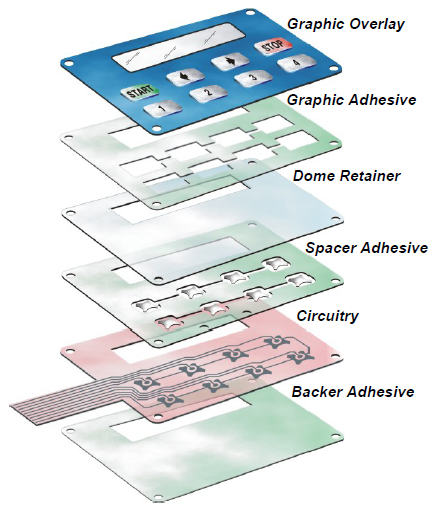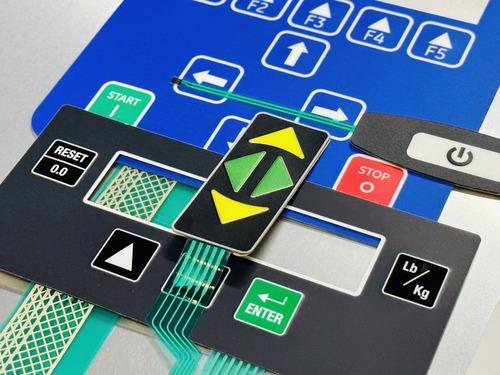Why Membrane Switches Are a Trick Part in Modern Electronic Tools
Why Membrane Switches Are a Trick Part in Modern Electronic Tools
Blog Article
Membrane Changes Explained: A Comprehensive Overview to Their Advantages
Membrane switches stand for a sophisticated and flexible option for developing interface throughout a selection of fields. Their multilayered style not just makes certain functionality via simple pressure yet additionally supplies considerable advantages, such as toughness and customization. As sectors increasingly look for reliable and dependable control interfaces, recognizing the certain benefits and applications of membrane changes ends up being crucial. Nevertheless, the intricacies of their layout and application present unique obstacles that value more detailed assessment. What aspects should be taken into consideration to fully utilize their potential in contemporary applications?
What Are Membrane Buttons?

When pressure is put on the membrane switch, the layers make call, completing an electric circuit. This straightforward system enables a vast array of applications, from consumer electronic devices to commercial equipment. Membrane layer switches are often designed to be immune and waterproof to dirt and contaminants, making them ideal for settings where durability is necessary.
In addition, the adaptability of the products utilized in membrane layer switches over assists in cutting-edge designs that can adapt numerous forms and measurements. This flexibility adds to their appeal in diverse fields, including clinical gadgets, automobile controls, and home appliances. Overall, membrane switches stand for an important component in modern user interface technology, linking the void between individuals and digital systems.
Key Advantages of Membrane Buttons
Amongst the myriad of interface choices offered, membrane layer switches stick out for their distinct combination of advantages. Among the key benefits is their light-weight and compact style, which enables integration into a large range of tools without including significant mass. This is especially advantageous in applications where area is limited.
In addition, membrane layer switches over offer longevity and resistance to environmental variables. They are typically constructed with products that can stand up to dampness, dust, and various chemicals, making them ideal for severe problems. This sturdiness adds to a longer life-span contrasted to conventional mechanical switches.
An additional substantial advantage is the convenience in modification. Membrane layer switches can be printed with different graphics, shades, and textures, permitting for tailored designs that fulfill certain branding or functional requirements. This adaptability includes the number of layers and circuit alternatives, giving designers with multiple configurations.
In addition, the tactile feedback provided by some membrane layer switches improves individual experience, making them more intuitive to operate. Last but not least, the convenience of cleansing and maintenance even more strengthens membrane layer switches as a practical option in both consumer and commercial applications. Membrane Switches. On the whole, these crucial benefits make them a favored option for several developers and suppliers
Applications in Numerous Industries
How do membrane layer switches find their place throughout varied sectors? Their flexibility and capability make them essential elements in sectors varying from health care to customer electronic devices. In clinical tools, membrane layer buttons are used for their simplicity of cleansing and resistance to contamination, making sure health in settings where sterility is critical.
In the consumer electronics market, these buttons offer sleek, easy to use user interfaces that enhance product visual appeals while preserving toughness versus wear and tear. Automotive applications benefit from membrane layer changes as well, where they are utilized in control panels and control panels, supplying trustworthy performance in difficult problems.
Furthermore, industrial machinery uses membrane layer switches for control board hop over to these guys because of their toughness, ability to endure harsh settings, and adjustable layouts that cater to particular functional demands. The food industry leverages membrane layer switches for their ease of usage and resistance to spills, guaranteeing functional performance in hectic settings.
Ultimately, the versatility of membrane switches throughout these diverse applications emphasizes their crucial duty in modern-day innovation, improving user interaction while meeting industry-specific needs. Their proceeded evolution assures further combination into arising fields and cutting-edge items.
Design and Personalization Options
The layout and modification options available for membrane layer buttons are vital for tailoring user interfaces to satisfy particular customer needs and aesthetic preferences. These switches can be created in numerous shapes, sizes, and designs, permitting seamless combination into varied applications. The versatility in style implies that makers can create distinct user interfaces that boost use and maintain brand name identity.
Custom textures, graphics, and shades can be put on the surface of the membrane layer button, giving an opportunity for branding and customer involvement. In addition, backlighting options, such as LED lighting, can be included to enhance visibility in low-light conditions, hence boosting capability.
Functional aspects can additionally be personalized, consisting of tactile feedback and actuation pressure, which can be adapted to match different user interactions. The option of products, such as polyester or polycarbonate, permits for variations in durability and environmental resistance, providing to the specific demands of various sectors.
Inevitably, the extensive design and modification capacities of membrane layer buttons enable business to develop visually enticing and easy to use user interfaces, making sure that their items satisfy both visual and useful needs effectively. Membrane Switches.
Considerations for Implementation
Implementing membrane switches over calls for mindful consideration of numerous elements to guarantee optimal functionality and user experience. Among the key considerations is the desired application setting. Aspects such as exposure to moisture, extreme temperatures, and chemical materials can substantially impact the button's performance and long life. Selecting materials that hold up against these conditions is vital.

One more vital element is the button's design and design. Making sure that the responsive feedback and actuation pressure line up with user expectations boosts usability. Carrying out individual testing can give important insights i loved this right into the optimal style.
Furthermore, compatibility with digital components must be examined. The switch's wiring must straighten with the overall system architecture, making sure trusted signal transmission and reducing disturbance.
Moreover, manufacturing methods and costs need to be assessed. The selection between customized designs and typical designs can lead and influence both spending plan time.
Finally, think about repair and maintenance. Membrane buttons might need certain cleansing and treatment procedures to keep their look and functionality gradually. By resolving these factors to consider, companies view can implement membrane buttons that satisfy their functional needs while giving a positive customer experience.

Verdict
In conclusion, membrane changes stand for a versatile and durable control interface appropriate for a large range of applications throughout numerous markets. Membrane Switches. As technology continues to advance, the importance of membrane layer buttons in modern-day gadgets stays substantial, supplying both functionality and visual appeal.
Membrane switches over represent a flexible and advanced solution for producing individual interfaces throughout a selection of sectors.Recognizing the basic elements of contemporary electronic user interfaces, membrane switches are a kind of individual interface gadget that consist of flexible, slim layers of product. Overall, membrane switches represent a critical component in contemporary individual interface technology, linking the space between users and digital systems.
Amongst the myriad of customer interface choices available, membrane switches stand out for their distinct combination of advantages.The design and modification options readily available for membrane buttons are crucial for tailoring interfaces to meet specific individual requirements and aesthetic choices.
Report this page